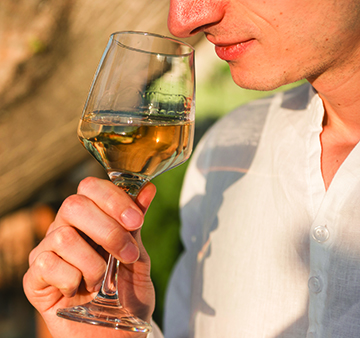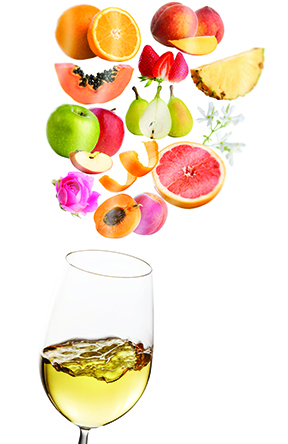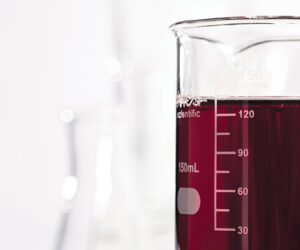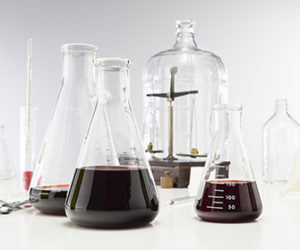
The sensory characteristics of wine are the main determinants of its quality. They are directly appreciated by drinkers, and are caused by the different chemical compounds that are present in wine and by their concentrations.
Olfactory perceptions are caused by volatile chemical compounds present in the air, in food, and in beverage. Humans are able to recognize from 10,000 to 100,000 different odors caused by chemical compounds belonging to many different chemical families.
Odoriferous substances are numerous in wine, and have very different chemical structures: Alcohols, hydrocarbons, thiols, ketones, aldehydes, amines, carboxylic acids, esters, and lactones. Each compound is present in wine in variable concentrations, which, in general, are very low: From mg/L (parts per million) to ng/L (parts per trillion). The simultaneous presence of so large a number of molecules makes the human perception of wine aromas a complex process.
These compounds have different origins:
• From the grapes.
• From enzymatic reactions occurring during crushing (mostly hexane, hexanol, and hexenol).
• From the activity of microorganisms during fermentations (alcoholic fermentation and possibly malolactic fermentation).
• From chemical and biological processes that occur during storage and aging.
Sensory thresholds are defined as the concentrations at which a particular odoriferous substance is perceived from the majority of people involved in the panel tests. These thresholds are highly variable, according to the chemical families.
Relating the chemical composition of wine to sensory perceptions of aromas is an extremely demanding and complex task, due to a series of interactions between the molecules.
In wine tasting, odor descriptors are frequently used; for instance, the descriptor “rose” indicates that that wine reminds of the rose odor. Some odors in wine have been successfully related to particular compounds (“impact odorants”), but in general they are conferred by mixtures
of substances.
The orthonasal way of perception of odorants and the perception in mouth can sometimes produce different sensations from the same compound. This is due to a more efficient extraction of odorants from wine in the mouth, where temperature is higher than in the glass. So, some compounds can be perceived already in the glass, because they are highly volatile and therefore easily extracted; other substances are less volatile, and can be properly perceived only in the mouth. The olfactory perception of some substances in the mouth can interact with other perceptions, such as tactile, leading to complex perceptions, not easily distinguished.
Varietal aromas
The odor compounds originated in the grapes during berry maturation are called varietal aromas (sometimes also called primary aromas), because they differ notably depending on the variety. These compounds are extracted from the skin of the berries during must extraction
or maceration.
A lot of recent scientific studies have investigated their structure, their abundance in different grape varieties, and their influence on wine aroma, because they can confer specific sensory characteristics to young wines. Aging can ruin the delicate molecules responsible for the
varietal aromas.
There is a consolidated attention to high-quality, aromatic wines and to the role of the grapes that give origin to these wines. Differences between grape varieties are relevant and depend mainly on the different composition of mixtures of odoriferous compounds; in only a few cases there is the presence of particular
impact odorants.
Thiols

Among the varietal aromas, volatile thiols (or mercaptans) are delicate but powerful aromatic compounds that are found in some grapes, mostly white, such as Sauvignon Blanc, Riesling, Chenin Blanc, Gewürztraminer, Colombard, Sémillon, Pinot Blanc, Pinot Gris, and Sylvaner. They have been also found in some local Italian grapes, such as Vermentino, Verdicchio, Grillo, Trebbiano di Lugana, and Grechetto. They are significantly present in some red varieties as well, such as Cabernet Sauvignon
and Merlot.
Usually they are odorless, normally being chemically bound to other compounds, which reduces the volatility of the molecules. During the fermentation, enzymes produced by the yeast metabolism split these bonds and release the volatile compounds. Once they are separated from the precursors, the human nose can sense their aromas.
All thiols present the -SH group (sulfhydryl group), which is the main chemical characteristic of this family of sulfur-containing compounds.
An aroma deeply influenced by these compounds is showcased in Sauvignon Blanc wines; it was studying these grapes two decades ago that research began to clarify the enological role of thiols. Research in this field is difficult, primarily because volatile molecules are recalcitrant to easy conclusions, secondly because thiols are present in wine at parts per trillion (ng/L), and therefore are difficult to detect.
A common feature of these molecules is their relative instability; they are easily oxidized during the must extraction and the initial phase of fermentation. If the winemaker wants to preserve them, cellar choices prior to fermentation are crucial for the quality of the future wine. When not destroyed by winemaking oxidation processes, these compounds are capable of developing positive aromas, such as boxy (box tree), passion fruit, grapefruit, tropical fruit, black currant, orange peel, and tomato leaf. It is interesting to note that these flavors belong to different aroma groups: Fruit, tropical, green (herbaceous or vegetable-like).
As to the descriptor “boxy,” it refers to the smell from boxwood plant leaves; boxwood plants (Buxus) are evergreen shrubs often planted in formal landscapes. It is interesting to note that chemical analysis of fresh boxwood leaves show significant concentrations of thiols, demonstrating that the descriptor “boxy” is precisely referred to this class of compounds. It is a rare case, because in general it is not so easy to link odor descriptors to certain chemical compounds.
Three main thiols are found in wines: 3MH (3-mercaptohexan-1-ol), 3MHA (3-mercaptohexyl acetate), and 4MMP (4-mercapto-4-methylpentan-2-one). The concentrations of thiols in grapes and wine are very low, but sufficient to give the olfactory sensation. It is surprising and somewhat disconcerting that the concentration of thiols (but of other wine odorants as well) can change their olfactory perception; for instance, at low concentrations 3MHA can deliver passion fruit, guava, and gooseberry odors, but at high concentration it imparts a sweaty aroma.
Preserving thiols
In order to avoid oxidation and retain thiols, it is mandatory to work in a reductive (that is, minimal oxygen concentration) environment and to use anti-oxidant preservatives, such as sulfur dioxide. The winemaking in reduction for white wines reckons on avoiding oxidation during the must elaboration, fermentation, maturation and bottling.
The must extraction is a key stage for the oxidation reactions that happen in presence of oxygen; using sulfite (anti-oxidant), sometimes coupled with ascorbic acid, and paying attention to pump-overs and rakings, protects thiols. Other tips to make wine in a reductive environment include using stainless steel, closed-top vessels and using pumps that do not increase oxygen concentration in must and wine.
Enhancing thiols concentration
In addition to preserving a grape’s thiols it is also possible to enhance their concentration. Here are some factors that have been shown to be effective for the purpose of enhancing thiols
in wine:
• Picking the grapes early is thought to favor the concentration of thiol precursors that begin to decrease prior to grape ripening.
• Cold maceration (prior to fermentation) is frequently adopted, increasing the extraction of thiols, which are mainly resident in the skins.
• Use yeast cultures that have been specifically selected to release varietal thiols (varietal thiols are released during fermentation by Saccharomyces cerevisiae yeast through its enzymatic activity). A list of some of these strains is included in the sidebar on this page.
• Bound thiols can be released through the use of exogenous enzymes during cold soaking of the must.
Wine yeasts that enhance volatile thiols
Some strains of Saccharomyces cerevisiae have been assessed for their ability to enhance the production of volatile thiols. Some examples:
AB BIOTEK – MAURIVIN
SAUVIGNON has the ability to
enhance the varietal aromas of
Sauvignon Blanc and of other thiolic grapes, thanks to the high activity of the ß-lyase enzyme, the one that
converts odorless precursors into aromatic thiols.
ENARTIS
FERM Q9 favors thiol production, the outcome being complex wines with intense citrus, grapefruit, tropical fruit, pear, and pineapple aromas.
LAFFORT
ZYMAFLORE® VL3 is a yeast strain known for expressing thiol-type
varietal aromas.
LALLEMAND
IOC BE THIOLSTM can enhance 3-MH potential (generally associated with grapefruit and contributing to pineapple notes) without excessive plant-based notes.
SAUVYTM has the ability to release volatile thiols, in particular 4MMP.
References:
Axel R., 2005. “Scents and sensibility: a molecular logic of olfactory perception” (Nobel Lecture). Angew. Chem. Int. Ed. 44:6110 – 6140
Buck B.L., 2004. “Unraveling the sense of smell.” Nobel lecture
Coetzee C., 2018. “Grape-Derived Fruity Volatile Thiols.” April 2018 Issue of Wines & Vines.
Dubourdieu D., Tominaga T., 2009. “Polyfunctional thiol compounds.” In Wine Chemistry and Biochemistry curated by Moreno-Arribas e M.C. Polo. Springer, pp.275-293
Ebeler S.E., Thorngate J.H., 2009. “Wine chemistry and flavor: looking into the crystal glass.” J. Agric. Food Chem. 57 8098–8108
Ferreira V., Cacho J., 2009. “Identification of impact odorants in wine.” Wine Chemistry and Biochemistry curated by Moreno-Arribas e M.C. Polo. Springer, pp.393-415
Fleet G.H., 2003. “Yeast interaction and wine flavour.” International Journal of Food Microbiology 86:11-22
Guth H., 1997. “Identification of character impact odorants of different white wine varieties.” J. Agric. Food Chem. 45:3022-3026
Polaškova P., Herszage J., Ebeler S.E., 2008. “Wine flavor: chemistry in a glass.” Chem. Soc. Rev. 37:2478–2489
Roland A., Schneider R., Razungles A., Cavelier F., 2011. “Varietal Thiols in Wine: Discovery, Analysis and Applications.” Chem. Rev., 111.
Mattivi F. et al., 2012. “Develop-
ment of reliable analytical tools
for evaluating the influence of reductive winemaking on the quality of Lugana wines.” Analytica Chimica Acta, vol. 732.
Zou Z., Buck B.L., 2006. “Combinatorial effects of odorant mixes in olfactory cortex.” Science 311: 1477-1481






